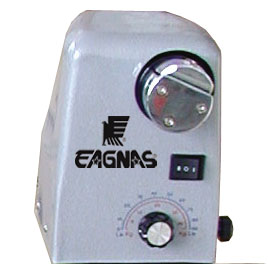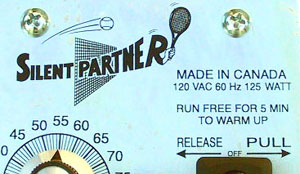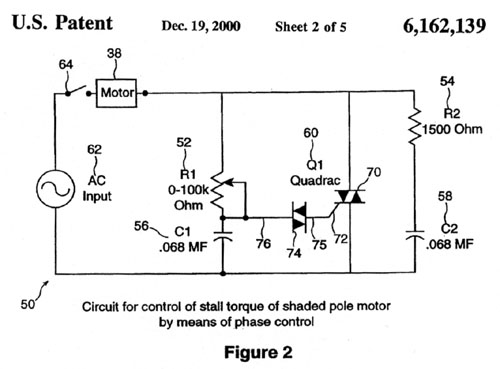
Electronic Tension Head
|

|
The Hawk tension head is the electronic tension head, which makes stringing much faster and easier:
The Silent Partner tension head is the electric tension head:
The DC (direct-current) motor needs more hardware to operate:
The AC (alternating-current) motor does not required to have the transformer, regulator and filter:
No, the Hawk electronic tension head utilizes the DC (direct-current) motor. It does not need any warm up tume at all. You just need to turn on the power switch and start to pull the tension immediately.
Actually the AC motor does not need any warm up tume at all. You can connect the power input and start to pull the tension immediately. But when the AC motor gets warm, it lowers tension. It means that when the AC motor is cold, it put higher tension. When the AC motor is warm, it put lower tension.
 | On the front panel of Silent Partner's AC motor electric tension head, it indicates that "RUN FREE FOR 5 MIN TO WARM UP". What is the reason? Just because the AC motor gets warm, it lowers tension. Silent Partner uses this statement to cover up this fact. |
The Silent Partnerís electric tensioner design (U.S. Patent No. 6,162,139) just uses the General Electric universal motor-speed control circuitry. Refer to the Figure 12-18 of the 1993 Small Electric Motors textbook.


Table 1 illustrates the comparison between the Silent Partnerís String Tensioning Device and the General Electric universal motor-speed control circuitry.
| Device | General Electric universal motor-speed control circuitry (Figure 12-18) | Silent Partner' String Tensioning Device (U.S. Patent 6,162,139 Figure 2) |
| Potentiometer R1 | 250K Ohms | 100K Ohms |
| Capacitor C1 | 0.1 Micro Farad | 0.068 Micro Farad |
| Resistor R2 | 100 Ohms | 1500 Ohms |
| Capacitor C2 | 0.1 Micro Farad | 0.068 Micro Farad |
| Control Devices | 1 Diac and 1 Triac | 1 Quadrac: One Quadrac device is one Triac that includes a Diac mounted inside the same package. See the Quadrac data sheet of the Triac manufacturer "Teccor Electronics". |
A professional stringer, Thomas E. Ruddy, tests a Silent Partner 2002 e.stringer.
Tenion pulled to correct tension most of the time, but lost more # than I thought it should. When tension pulled not enough stable or constant pulled to have a even racket strung. I have strung for the US Davis Cup team. I have also strung for school districts in and out California,
Montebello, Whittier, San Jose, San Luis Obispo, San Diego, New York Germantown middle school district. Also US badminton team 84-88, 92 Olympic teams, to present 2002.
| Machine Under Test: | 2002 September e.Stringer model (purchased in September 2002) |
| Test Equipment: | Silent Partner tension calibrator (purchased in September 2002) Silent Partner Original Syn 16G string (purchased in September 2002) |
| Initial Setup (Calibration): | Follow the HELPFUL HINT FOR CALIBRATION on page 9 of the Owner's manual:
|
| Reference Tension | Initial Pull Tension | 3 Second Later Tension | 10 Second Later Tension |
| 30 LBS | 27 LBS | 25 LBS | 21 LBS |
| 30 LBS | 26 LBS | 25 LBS | 24 LBS |
| 30 LBS | 28 LBS | 25 LBS | 23 LBS |
| 30 LBS | 30 LBS | 26 LBS | 25 LBS |
| 30 LBS | 30 LBS | 26 LBS | 22 LBS |
| 35 LBS | 32 LBS | 25 LBS | 20 LBS |
| 35 LBS | 32 LBS | 28 LBS | 24 LBS |
| 35 LBS | 35 LBS | 30 LBS | 18 LBS |
| 35 LBS | 35 LBS | 31 LBS | 28 LBS |
| 35 LBS | 35 LBS | 30 LBS | 26 LBS |
| 40 LBS | 40 LBS | 36 LBS | 35 LBS |
| 40 LBS | 40 LBS | 36 LBS | 36 LBS |
| 40 LBS | 36 LBS | 35 LBS | 34 LBS |
| 40 LBS | 40 LBS | 36 LBS | 35 LBS |
| 40 LBS | 41 LBS | 39 LBS | 36 LBS |
| 45 LBS | 46 LBS | 41 LBS | 40 LBS |
| 45 LBS | 43 LBS | 39 LBS | 36 LBS |
| 45 LBS | 44 LBS | 40 LBS | 36 LBS |
| 45 LBS | 44 LBS | 40 LBS | 37 LBS |
| 45 LBS | 44 LBS | 39 LBS | 36 LBS |
| 50 LBS | 50 LBS | 46 LBS | 45 LBS |
| 50 LBS | 49 LBS | 44 LBS | 43 LBS |
| 50 LBS | 49 LBS | 44 LBS | 41 LBS |
| 50 LBS | 49 LBS | 46 LBS | 41 LBS |
| 50 LBS | 50 LBS | 46 LBS | 41 LBS |
| 55 LBS | 57 LBS | 52 LBS | 51 LBS |
| 55 LBS | 56 LBS | 51 LBS | 50 LBS |
| 55 LBS | 56 LBS | 51 LBS | 49 LBS |
| 55 LBS | 56 LBS | 50 LBS | 49 LBS |
| 55 LBS | 56 LBS | 50 LBS | 48 LBS |
| 60 LBS | 62 LBS | 59 LBS | 55 LBS |
| 60 LBS | 65 LBS | 58 LBS | 56 LBS |
| 60 LBS | 66 LBS | 61 LBS | 60.5 LBS |
| 60 LBS | 66 LBS | 59 LBS | 56 LBS |
| 60 LBS | 66 LBS | 59 LBS | 56 LBS |
| 65 LBS | 70 LBS | 64 LBS | 60.5 LBS |
| 65 LBS | 70 LBS | 64 LBS | 61 LBS |
| 65 LBS | 70 LBS | 62 LBS | 60 LBS |
| 65 LBS | 69 LBS | 61 LBS | 60 LBS |
| 65 LBS | 71 LBS | 62 LBS | 60.25 LBS |
| 70 LBS | 76 LBS | 67 LBS | 66 LBS |
| 70 LBS | 76 LBS | 69 LBS | 66 LBS |
| 70 LBS | 76 LBS | 69 LBS | 65.5 LBS |
| 70 LBS | 77 LBS | 68 LBS | 66 LBS |
| 70 LBS | 79 LBS | 70.5 LBS | 70 LBS |
| Reference Tension | Initial Pull Tension | 3 Second Later Tension | 10 Second Later Tension | Tension Drop to Re-trigger Motor Pull | Motor Pulls Tension |
| 30 LBS | 30 LBS | 24 LBS | 22 LBS | ||
| 30 LBS | 31 LBS | 25 LBS | 24 LBS | 8 LBS | 16 LBS |
| 40 LBS | 40 LBS | 32 LBS | 31 LBS | 16 LBS | 25.5 LBS |
| 40 LBS | 40.5 LBS | 35 LBS | 31 LBS | 16 LBS | 25 LBS |
| 50 LBS | 50 LBS | 41 LBS | 39 LBS | 26 LBS | 39 LBS |
| 50 LBS | 50 LBS | 41 LBS | 40 LBS | 26 LBS | 39 LBS |
| 55 LBS | 56 LBS | 46 LBS | 45 LBS | 25 LBS | 55 LBS |
| 55 LBS | 56 LBS | 45 LBS | 41 LBS | 30 LBS | 45 LBS |
| 60 LBS | 61 LBS | 56 LBS | 55 LBS | 30 LBS | 46 LBS |
| 60 LBS | 61 LBS | 55 LBS | 54 LBS | 36 LBS | 49 LBS |
Test By Thomas E. Ruddy
Date: 10-13-02
If you have the Silent Partner e.Stringer, please let us know how is your e.Stringer performance.
Silent Partner's FAQ#4:
4) Are all electronic machines based on the same technology?
Important differences distinguish the technologies used in various electronic machines. There are three types of technologies. The first consists of electronics for direct torque control of a motor so that the motor cannot pull more than the desired tension. Silent Partner holds a patent for this technology (US Patent #6,162,139) and offers it exclusively on the e.Stringer, the e.Stringer CL and the e.Stringer FL, as well as in retrofit tensioners for other brands of machines. The second type of electronic technology consists of a motor control linked mechanically to a pre-loaded spring. Tension adjustment is effected by turning a knob that compresses the spring to the desired tension so that a limit switch is tripped and the motor is stopped when the tension is reached. This type of control, which is identified by a tension control knob located to the right of the machine (see picture), does not provide constant pull because tension has to drop by more than 15 lbs. for the limit switch to turn the motor on again, and this does not normally happen during stringing...
A professional stringer, Thomas E. Ruddy, tests a Silent Partner 2002 e.stringer.
Tenion pulled to correct tension most of the time, but lost more # than I thought it should. When tension pulled not enough stable or constant pulled to have a even racket strung. I have strung for the US Davis Cup team. I have also strung for school districts in and out California,
Montebello, Whittier, San Jose, San Luis Obispo, San Diego, New York Germantown middle school district. Also US badminton team 84-88, 92 Olympic teams, to present 2002.
| Reference Tension | Initial Pull Tension | 3 Second Later Tension | 10 Second Later Tension | Tension Drop to Re-trigger Motor Pull | Motor Pulls Tension |
| 30 LBS | 30 LBS | 24 LBS | 22 LBS | ||
| 30 LBS | 31 LBS | 25 LBS | 24 LBS | 8 LBS | 16 LBS |
| 40 LBS | 40 LBS | 32 LBS | 31 LBS | 16 LBS | 25.5 LBS |
| 40 LBS | 40.5 LBS | 35 LBS | 31 LBS | 16 LBS | 25 LBS |
| 50 LBS | 50 LBS | 41 LBS | 39 LBS | 26 LBS | 39 LBS |
| 50 LBS | 50 LBS | 41 LBS | 40 LBS | 26 LBS | 39 LBS |
| 55 LBS | 56 LBS | 46 LBS | 45 LBS | 25 LBS | 55 LBS |
| 55 LBS | 56 LBS | 45 LBS | 41 LBS | 30 LBS | 45 LBS |
| 60 LBS | 61 LBS | 56 LBS | 55 LBS | 30 LBS | 46 LBS |
| 60 LBS | 61 LBS | 55 LBS | 54 LBS | 36 LBS | 49 LBS |
Test By Thomas E. Ruddy
Date: 10-13-02
Refer to the complete test report.